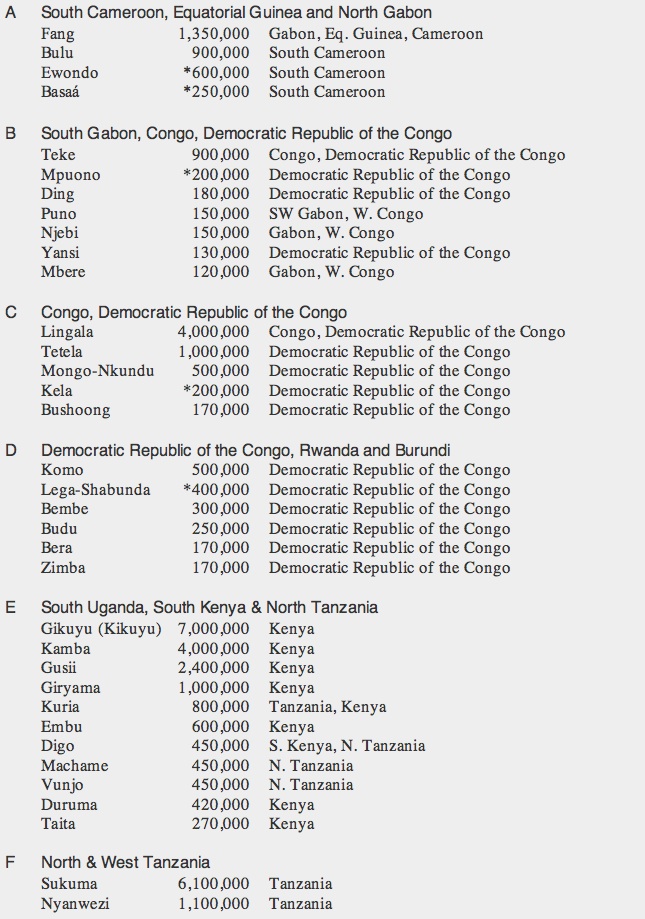An insatiable appetite for ancient and modern tongues


Name Origin. The term Bantu was created by a scholar in the 19th century as the reconstructed word for 'people' in the hypothetical ancestor language of the group.
Overview and Distribution. The Bantu languages are a very large group, belonging to the Benue-Congo family of the Niger-Congo phylum, which comprises between 250 to 500 members spread over most of sub-Saharan Africa. They are spoken by nearly one-third of the population of the continent, approximately 330 million people. They are prevalent to the south of a line going from western Cameroon to southern Somalia, reaching the far end of the continent. One Bantu language, Swahili, is used as a lingua franca in East Africa by about 50 to 100 million people. Other major languages of the group, each with 10 million speakers or more, are Rwanda, Luba, Nyanja, Shona, and Zulu.
External Classification: Niger-Congo, Volta-Congo, Benue-Congo, Eastern Benue-Congo, South Bantoid, Bantu.
click on the map to enlarge
Note: the map depicts the entire Niger-Congo phylum. Bantu languages are in pink. Capital letters correspond to language groups mentioned below. Numbers 15-38 identify the major Bantu languages.
Internal Classification. Based on shared characteristics and on territorial contiguity, Guthrie grouped the Bantu languages into 15 geographical (and partly genetical) zones. Each zone is divided into groups, numbering in total 85. His classification has been updated by Maho (language name in the 1st column, speaker numbers in the 2nd, and distribution in the 3rd, data marked with an asterisk is unreliable):



Note: In western South Africa (Western Cape and Northern Cape provinces) Afrikaans is predominant but Bantu languages are also spoken. According to the 2011 census, Xhosa is spoken by 24.7 % of the population of Western Cape, and Tswana by 33.1 % of the population of Northern Cape.
SHARED FEATURES
-
✦ Phonology
-
-Syllables are almost always open i.e. they end in a vowel. They are, usually, CV or CVV.
-
-About 60 % of all Bantu languages have a five-vowel system: i, ɛ, a, u, ɔ. Many others have a seven-vowel system: i, e, ɛ, a, u, o, ɔ.
-
-The consonantal system includes prenasalized stops (voiced and voiceless).
-
-Most Bantu languages have tones which serve to make lexical and/or grammatical distinctions.
-
-Stress usually falls on the penultimate syllable.
-
✦ Morphology
-
-The most distinctive morphological feature of Bantu languages is the grouping of nouns in different classes, marked by a prefix. All members of a given class share the same prefix. Some classes are semantic, others are based on grammatical categories but many are heterogeneous. There is no gender distinction.
-
-Proto-Bantu had 19 classes, most of which have been conserved in its descendant languages, though some classes have been lost in a number of them. Classes 1-10 and 12-13 were paired, the first member of the pair was for singular nouns, the second for plural nouns. Classes 16-18 had no actual words. The 19 noun classes of Proto-Bantu were:
-
Classes 1-2 for people.
-
Classes 3-4 for plants, trees and natural phenomena.
-
Classes 5-6 for objects that come in pairs or larger groups.
-
Classes 7-8 were heterogeneous.
-
Classes 9-10 included animals and miscellanea.
-
Class 11 for extended body parts. Uses plural of classes 6 and 10.
-
Classes 12-13 for diminutives.
-
Class 14 for abstract qualities.
-
Class 15 for verbal infinitives.
-
Class 16 for locatives (where).
-
Class 17 for locatives (around which).
-
Class 18 for locatives (in which).
-
Class 19 for diminutives. Uses plural of classes 6, 8, 10 and 13.
-
-Another distinctive feature of Bantu languages is the system of agreement or concordance between noun modifiers and the noun i.e., they all share the same class prefix. This concord extends also to the verb, and to the subject, object and relative markers.
-
-Bantu languages are essentially agglutinative and that characteristic is most evident in their verbal systems. The verbal complex consists of a series of discrete morphemes: subject concord marker-tense marker-object marker-stem-voice/mood marker. Verbal stems are, generally, disyllabic.
-
-Voice marking is an important feature of the verb, including causative, reciprocal, repetitive, passive, etc.
-
-Negation is also encoded in the verb complex. Many languages have one type of negative for subordinate clauses and another for main clauses.
-
✦ Syntax
-
-Subject-Verb-Object is the basic order but it can change to emphasize a constituent, frequently displacing the focused elements to the right of the verb. Within the noun phrase, all modifiers follow the head noun. Prepositions are used.
-
-Yes/no questions are indicated by tone and/or by a question marker while wh-questions are expressed by an interrogative word, in both cases without alteration of word order.
-
© 2013 Alejandro Gutman and Beatriz Avanzati
Further Reading
-
-African Languages. B. Heine & D. Nurse (eds). Cambridge University Press (2000).
-
-Comparative Bantu (4 vols). M. Guthrie. Gregg International Publishers (1967-70).
-
-The Bantu Languages. D. Nurse & G. Philippson (eds). Routledge (2003).
-
-Paths in the Rainforest. J. Vansina. The University of Wisconsin Press (1990).
Bantu Languages

Address comments and questions to: gutman37@yahoo.com
MAIN LANGUAGE FAMILIES
LANGUAGE AREAS
Languages of Ethiopia & Eritrea
LANGUAGES by COUNTRY
LANGUAGE MAPS
-
• America
-
• Asia
-
Countries & Regions
-
-
Families
-
• Europe
-
• Oceania
